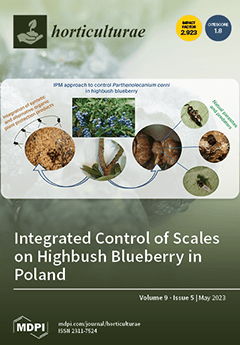The present study focuses on the nutritional, phytochemical composition, and antioxidant activities of the fruits of
Rourea minor (Gaertn.) Alston., an underutilized plant species. The ripened seeds contained 0.28%, 12.39%, 25.70%, 1.4%, and 3.4% of fat, protein, carbohydrate, ash, and fiber, respectively, whereas
[...] Read more.
The present study focuses on the nutritional, phytochemical composition, and antioxidant activities of the fruits of
Rourea minor (Gaertn.) Alston., an underutilized plant species. The ripened seeds contained 0.28%, 12.39%, 25.70%, 1.4%, and 3.4% of fat, protein, carbohydrate, ash, and fiber, respectively, whereas ripened pulp possessed 0.19%, 0.34%, 0.90%, 0.35%, and 0.98% of fat, protein, carbohydrates, ash, and fiber, respectively. The ripened seed and pulp were also rich in mineral elements and especially microelements. The pulp, when ripe, had high levels of microelements such as boron, iron, zinc, copper, and manganese with values of 25.98, 2523.56, 499.12, 33.62, and 40.30 µg/g DW, respectively. Phytate and oxalate content were comparatively higher in ripened seeds (6.91 and 31.88 mg/g FW) than in the pulp. Acetone, absolute methanol, water, and 70% methanol were used for the extraction of phytochemicals, and 70% methanol extract contained the highest phytochemicals. The total phenolic, flavonoid, and alkaloid content of unripe seeds was 180.47 mg gallic acid equivalent (GAE)/DW, 68.95 quercetin equivalent (QE)/g DW, and 0.35 atropine equivalent (AE)/g DW, respectively, and that of unripe pulp was 8.21 mg GAE/g DW, 2.97 mg QE/g DW and 1.20 mg AE/g DW, respectively. All the extracts showed remarkable antioxidant activity, proved by 2,2-diphenyl-1-picrylhydrazyl (DPPH) radical scavenging activity, total antioxidant activity, and ferric-reducing antioxidant power (FRAP) assay, following a similar trend to the phytochemical composition. The study concludes that
Rourea minor fruits, both seeds, and pulp, could be an excellent source of nutrients, microelements, and antioxidants.
Full article





